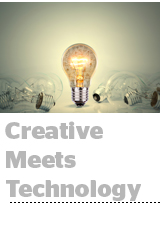 As Targeting Becomes Old Hat, Ad Tech Turns To Creative
As Targeting Becomes Old Hat, Ad Tech Turns To Creative
Marketing and ad tech companies are becoming more involved in creative planning and production.
Ad tech vendors compete to out-optimize campaigns by even a fraction of a percent, said McKinsey partner Ed See, who leads the consultancy’s marketing practice.
“But in the past few years, the power of targeting has mostly run its course,” See said, and now the data-driven competition for media budgets is eyeing creative as a way to drive ROI.
The trend directly impacts agency holding companies with legacy creative and digital media. WPP, for instance, recently took two of its storied creative shops, Young & Rubicam and J. Walter Thompson, and merged each with a data-driven agency, VML and Wunderman, respectively, as a way to reinvigorate their production.
“The last few years the industry has been laser-focused on efficiencies,” said Wesley ter Haar, co-founder and COO of the creative agency MediaMonks, which is known for shipping content quickly for dynamic content optimization (DCO) and was acquired late last year by S4 Capital. “What hasn’t happened much until recently is taking feedback from the data and trading and incorporating that back into creative.”
Souped up DCO
For many, the phrase “programmatic creative” conjures up DCO, but adoption has been limited to performance advertisers relying on a handful of vendors to execute advanced retargeting campaigns.
“Now that marketers are writing actual predictive models for creative optimization that feed into programmatic bidders, DCO will gather incredible pace,” said Nikki Mendonça, Accenture Interactive’s global president of operations.
And marketing tech companies are investing more in creative data services.
Adobe in particular has lately made progress connecting creative to media. In addition to integrating its own Creative Cloud and Experience Cloud, the company has struck partnerships with WPP and Accenture that grant content and creative agencies access to media via API integrations.
“In the past year customers have been asking for a much faster pace to share creative content to advertising,” said Elliot Sedegah, Adobe’s group manager for strategy and product marketing.
Connecting the Creative Cloud to programmatic media is a priority for Adobe right now, Sedegah said, because marketers are figuring out how creative design drives data-driven advertising and could bring a new wave of value to Adobe’s creative product suite.
Data-driven creative is mostly hypothetical but is bringing the right people together at earlier stages in the campaign strategy, See said. “It reminds me of the early days of multitouch attribution when brands had a sense that it was something they needed and began implementing and testing it across their partners.”
What does it take to measure creative?
Creative optimization isn’t for the faint of heart.
A brand needs to be committed to significant investments in A/B testing and post-impression surveys and ideally run multitouch attribution and media mix modeling, See said.
“Brands need a concrete creative metric or score in order to optimize in real-time, but if you just do last-touch measurement and some A/B testing it isn’t going to work,” See said.
For DCO to work, the creative strategy agency needs to have “a handshake relationship” with media buyers, ter Haar said. Only brands with strong in-house marketing tech have that feedback loop, he said, but tech vendors or agencies like MediaMonks can start with incremental steps like optimizing creative based on location or time of day to demonstrate ROI and get brands more interested in cloud technology and other investments to back DCO.
The weight loss and health brand WW (recently rebranded from Weight Watchers) began using a creative metric to optimize campaigns last year and found it more effective than optimizing direct engagements like clicks, said Darryl Hall, the company’s digital special projects manager. WW uses Flashtalking’s Creative Performance Index, a product for optimizing based on creative.
Hall said it takes upfront investments in media, attribution tech and first-party data management so the brand has a “single source of truth we’re confident in.” Then it could take weeks or even months to rejigger trading algorithms by backtracking from conversions to identify which creative units drove actual results.
Put a creative agency in a meeting about modeling and attribution and you’ll get blank stares, Hall said. “But they want the creative to work for us and we’ve seen month-to-month changes in the creative when we bring media data back into the planning process.”
This post was syndicated from Ad Exchanger.


More Stories
M+AD takes break for Anzac Day commemoration
Sustainability Is More Than a Big Leafy Green Picture
Google Won’t Pull Cookies In 2024